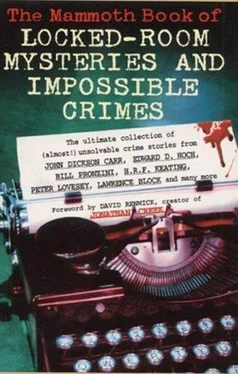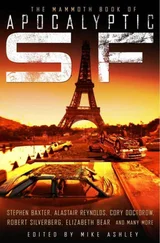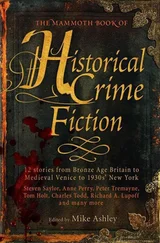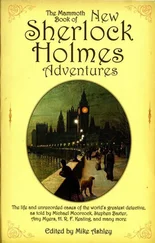Mike Ashley - The Mammoth Book of Locked-Room Mysteries And Impossible Crimes
Здесь есть возможность читать онлайн «Mike Ashley - The Mammoth Book of Locked-Room Mysteries And Impossible Crimes» весь текст электронной книги совершенно бесплатно (целиком полную версию без сокращений). В некоторых случаях можно слушать аудио, скачать через торрент в формате fb2 и присутствует краткое содержание. Жанр: Детектив, на английском языке. Описание произведения, (предисловие) а так же отзывы посетителей доступны на портале библиотеки ЛибКат.
- Название:The Mammoth Book of Locked-Room Mysteries And Impossible Crimes
- Автор:
- Жанр:
- Год:неизвестен
- ISBN:нет данных
- Рейтинг книги:3 / 5. Голосов: 1
-
Избранное:Добавить в избранное
- Отзывы:
-
Ваша оценка:
- 60
- 1
- 2
- 3
- 4
- 5
The Mammoth Book of Locked-Room Mysteries And Impossible Crimes: краткое содержание, описание и аннотация
Предлагаем к чтению аннотацию, описание, краткое содержание или предисловие (зависит от того, что написал сам автор книги «The Mammoth Book of Locked-Room Mysteries And Impossible Crimes»). Если вы не нашли необходимую информацию о книге — напишите в комментариях, мы постараемся отыскать её.
A new anthology of twenty-nine short stories features an array of baffling locked-room mysteries by Michael Collins, Bill Pronzini, Susanna Gregory, H. R. F. Keating, Peter Lovesey, Kate Ellis, and Lawrence Block, among others.
The Mammoth Book of Locked-Room Mysteries And Impossible Crimes — читать онлайн бесплатно полную книгу (весь текст) целиком
Ниже представлен текст книги, разбитый по страницам. Система сохранения места последней прочитанной страницы, позволяет с удобством читать онлайн бесплатно книгу «The Mammoth Book of Locked-Room Mysteries And Impossible Crimes», без необходимости каждый раз заново искать на чём Вы остановились. Поставьте закладку, и сможете в любой момент перейти на страницу, на которой закончили чтение.
Интервал:
Закладка:
“The length of the piece of steel, including the cork handle,” he read from the paper, “is nine and a half inches, and the weight is exactly one ounce.”
Golbourne turned to the table and again figured away busily.
“There’s something wrong, something funny somewhere,” he said at length.
“A piece of steel of the thinness and the evident suppleness of the weapon which killed Sir George couldn’t possibly weigh an ounce; at least, I don’t think so; but we’ll see after we’ve been to Bow Street, and when we get to Scotland Yard, for that’s where I want to go to see that steel. What about our seeing the car? Will that be all right?”
“Yes, they said at The Wire that the police would be only too glad to show it to us if we mentioned that we were working for the paper.”
“Come along, then.”
They hailed a taxi as soon as they got outside, and were soon being shown the motor-car of the late Sir George Borgham in the yard at Bow Street Police Station.
It was one of the very latest makes, with long sliding, lifting windows in front and at the sides. The two side windows were open; and the one at the left of the driver’s seat was lowered also, the one in front of which the driver sat being closed.
“Is that exactly how it was found when the car arrived at the Law Courts?” asked Golbourne of the officer who was with them.
“Exactly,” was the reply. “The old gentleman always liked plenty of fresh air, so his chauffeur said, and almost invariably had the windows open.”
“If there’s no objection to having one of the doors opened,” said Golbourne, “I should like to take a measurement. I suppose there are no finger-marks on the door handles?”
“No, there are none. That’s one of the first things we do – try for finger-prints,” smiled the officer.
Golbourne produced a tape-measure, and with the assistance of Bowen took just one measurement – the height of the car from the floor to the roof. Then, after thanking the police for their courtesy, the two members of the Murder Club left.
“Tom,” said Golbourne when they were outside, “there’s a quiet little eating-house close by, which I believe boasts of excellent beer and sandwiches, both of which are things of delight. Let us go and lunch while I make certain observations.”
At the little table to which their orders were brought, Golbourne again used his pencil and paper. At length he slipped them back into his breast pocket, and with an air of triumph, almost pointed a finger at Bowen.
“Tom,” he said, “I think I’ve discovered how Sir George Borgham was killed!”
The Rev. Thomas Bowen drew in his breath with a gasp of surprise.
“But by whom,” continued the professor, “and where, it’s at present impossible to say. We’ll go down to the office of The Wire now and get Brinsley to take us to Scotland Yard, where the inspector in charge of the case will, no doubt, allow us to examine the steel which was found in Sir George’s heart.”
“You’ve found out something!” was Brinsley’s greeting when they arrived at The Wire office. “I’m sure, professor, I can see a glint of triumph in your eye. What have you to say?”
“With the powerful resources of The Wire , Mr Brinsley,” said Golbourne, smiling pleasantly, “could you tell us at what rate the wind was blowing in the neighbourhood of the Strand, between twenty minutes and five minutes to ten on the morning of the day on which Sir George Borgham was killed? Do you think they would tell you at the Meteorological Offices in South Kensington?”
“Surely!” said Brinsley. “I’ll get them on the ‘phone myself at once… Hallo – hallo! Meteorological Society?… Yes, it’s the editor of The Wire speaking. Could you tell me at what rate the wind was blowing in London at between twenty and five minutes to ten?… Thanks – just a minute, please… Here, professor, I think you’d better come. It’s a bit too technical for me – something about pressure and weight and atmosphere, and all sorts of strange things.”
Golbourne went to the telephone, listened, and jotted down some notes.
“Give me five minutes to myself,” he said when he’d finished and put back the receiver, “and then I’ll get you to take us to Scotland Yard, Mr Brinsley, if you will.”
In a few minutes Golbourne looked up from his calculations.
“I think,” he said, “that I’ve got at the way in which Sir George was killed. Shall we go to Scotland Yard now and see the weapon? Then I can tell better.”
Inspector Mirch, who had charge of the case, received them with the usual courtesy extended by the police to the Press. The researches of the Murder Club were familiar, and, indeed, had been exceedingly useful, to the authorities, and the inspector willingly produced every exhibit in connection with this latest murder mystery looking with obvious curiosity at the silver-haired, white-moustached, elderly man who asked if he might be allowed to handle the deadly piece of steel.
“But a strip of steel of that length and width,” said Golbourne, “wouldn’t weigh an ounce, but about three-quarters of an ounce.”
“How do you know that, sir?” asked the inspector.
“I should be a poor professor of mathematics if I couldn’t measure and weigh things with my eye,” smiled Golbourne. “Now let us see if the cork weighs the other quarter to make up the full ounce?”
Scientific appliances of every kind are in use at Scotland Yard, including delicate scales which will weigh a thread of silk or a woman’s hair. And after experimenting the inspector said:
“Forty grains under a quarter of an ounce.”
“Of course! I was wrong. I forgot the steel!” Golbourne spoke with excitement. “Gentlemen, I can now tell you how Sir George Borgham was killed!”
The silence in that large square room overlooking the Embankment was only broken for a second or two by the rumble of the traffic outside, and then Golbourne spoke again.
“I think, Mr Inspector,” he said, “that if you cut open that cork, you’ll find that it is weighted inside to make up the exact quarter of an ounce, minus the fraction of weight given by the steel inserted into it.”
Mirch hesitated for a second, and then cut the cork across, severing it in two pieces. The inside proved to be slightly hollowed, and out rolled four or five little round shots of lead.
“Ah! I thought it was weighted,” cried Golbourne triumphantly. “Put these in the scales and you will find that it is they which brought the cork up to a quarter of an ounce, an unusual weight for one of its size.”
Further experiments proved that Golbourne’s calculations were correct.
Then the professor took up one of the pieces of cork, and probed and pricked at it with a pocket knife, and gradually eased the pieces into two.
“You see,” he said, taking up the other half and performing the same operation on it, “the cork was cut in two lengthways, the inside hollowed, the shot inserted, and the cork fastened together again with a strong adherent. It was cleverly done, too.”
“What else have you to say about it, sir?” asked the inspector.
“This,” Golbourne spoke solemnly. “Sir George Borgham was killed with this weapon from a distance of ten feet and a height of eight feet.”
Silence, and again silence, broken after a few tense seconds by Inspector Mirch, who said, without any idea of sarcasm:
“Who was the murderer, then?”
“I don’t know. At least, I’m not sure,” answered Golbourne thoughtfully. “But could you, Inspector, obtain from the Admiralty the address of Sebastian Sanchez? He’s a Spaniard by birth, a naturalized Englishman now. We might call on him. He came over from Brazil just before the War, and was employed at the Admiralty during hostilities. I worked with him there.”
Читать дальшеИнтервал:
Закладка:
Похожие книги на «The Mammoth Book of Locked-Room Mysteries And Impossible Crimes»
Представляем Вашему вниманию похожие книги на «The Mammoth Book of Locked-Room Mysteries And Impossible Crimes» списком для выбора. Мы отобрали схожую по названию и смыслу литературу в надежде предоставить читателям больше вариантов отыскать новые, интересные, ещё непрочитанные произведения.
Обсуждение, отзывы о книге «The Mammoth Book of Locked-Room Mysteries And Impossible Crimes» и просто собственные мнения читателей. Оставьте ваши комментарии, напишите, что Вы думаете о произведении, его смысле или главных героях. Укажите что конкретно понравилось, а что нет, и почему Вы так считаете.










